 If you have a flock of chickens, you always have something interesting to photograph. Chickens have such quirky personalities and beautiful plumage it’s natural to want to capture that.
If you have a flock of chickens, you always have something interesting to photograph. Chickens have such quirky personalities and beautiful plumage it’s natural to want to capture that.
You don’t need special photography equipment to take quality photographs of your chickens. In fact, the cameras on some of the cell phones nowadays can capture some pretty impressive images.
Work with what you have
Whether you have an inexpensive point and shoot or the latest Cannon SLR, it’s important to know what your camera is capable of and use that to your advantage.
Take lots of photos. When one turns out that you like, try to remember what you did to get that result. Was it a setting on your camera? A certain time of day? Was the weather or lighting bright, shadow-y, overcast? Were the chickens in a certain part of the yard, were you standing under them while they roosted? Know your camera and how it performs. And the only way to do that is to use your camera often.
Tell a Story
 Even a poor quality photo that tells a great story can be a good capture. The story can be subtle. Maybe it’s a nostalgic feel of chickens sprinkled across the lawn, or maybe it’s a summer Sunday afternoon, and a sleeping chicken gives it that lazy feel. Or the story can be more obvious like a chicken stealing a treat and running away from the other chickens, or your first egg hatching. The story can come from the literal subject matter, or from more of an ambiance. It’s important to feel what you’re shooting and try to translate that through the lens.
Even a poor quality photo that tells a great story can be a good capture. The story can be subtle. Maybe it’s a nostalgic feel of chickens sprinkled across the lawn, or maybe it’s a summer Sunday afternoon, and a sleeping chicken gives it that lazy feel. Or the story can be more obvious like a chicken stealing a treat and running away from the other chickens, or your first egg hatching. The story can come from the literal subject matter, or from more of an ambiance. It’s important to feel what you’re shooting and try to translate that through the lens.
Tell the story with as little “words” as possible
They say a picture paints a thousand words, then as a photographer you need to become a good editor of imagery. To use the writing analogy, a good story doesn’t have a lot of extra words to muddle and confuse the reader. The same goes with photography. When photographing chickens, fill your view with what’s important to the image. If you want to show a chicken’s personality, zoom in to its face, show it’s features and cut out what isn’t necessary. You don’t need to photograph the whole chicken to show the wattle. Decide what’s important to the image and edit the rest.
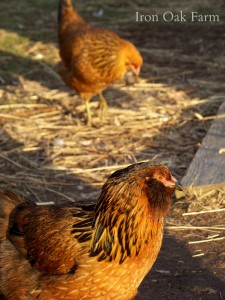 This doesn’t mean that every photograph has to be zoomed into a single focal point. In fact, some of the most interesting images have the focal point off to one side, or in a corner with something complimentary or contrasting off in the distance.
This doesn’t mean that every photograph has to be zoomed into a single focal point. In fact, some of the most interesting images have the focal point off to one side, or in a corner with something complimentary or contrasting off in the distance.
 The focus of this photo (right) is the rooster, however I wanted to show the tractor as well to give the image an over all “farm” feeling.
The focus of this photo (right) is the rooster, however I wanted to show the tractor as well to give the image an over all “farm” feeling.
Try turning the camera. Is the image long and lean, flip the view to portrait. Are you taking a photo of a wide line of chickens then go to landscape.
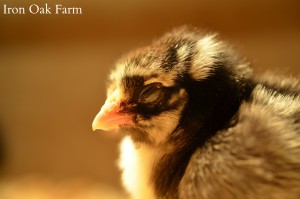 I wanted this to be an intimate photo, concentrating on the chick’s sleepiness and the little drip under his chin. I wanted to show the details of the beak and the soft down feathers. I didn’t have to photograph the entire chick for that to come through.
I wanted this to be an intimate photo, concentrating on the chick’s sleepiness and the little drip under his chin. I wanted to show the details of the beak and the soft down feathers. I didn’t have to photograph the entire chick for that to come through.
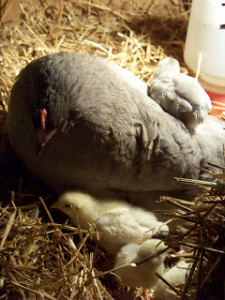 Try to shoot the unusual. The internet is full of perfect profile shots of chickens. My favorite photos show chickens in a new light. What does the photo in your frame really say about the life of a chicken? What does it show about their personality?
Try to shoot the unusual. The internet is full of perfect profile shots of chickens. My favorite photos show chickens in a new light. What does the photo in your frame really say about the life of a chicken? What does it show about their personality?
Think about what you think is beautiful about your flock, then try to convey that feeling through the camera. Is it the gentle way they drift off to sleep on a warm day, or is it the powerful force of your favorite rooster crowing? Try to tell that story.
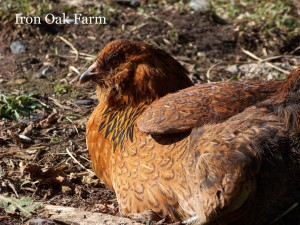 Get low
Get low
Some of the most interesting ways to photograph chickens is to take photos from different angles. We are humans so most of us stand between 5 and 7 feet approximately. We see the world from this vantage point, which means most of the time, when we look at our flock we see their backs.
To make my photography interesting I like to change the view of the world. Try taking the photos at the same level as a chicken would stand. This gives the impression that you’re down in with the flock.
 Try photographing a rooster while he’s up on a perch. This will give him a mighty feel.
Try photographing a rooster while he’s up on a perch. This will give him a mighty feel.
 Shooting around fences and chicken wire
Shooting around fences and chicken wire
Sometimes the inclusion of chicken wire in photography can give the photo a nice nostalgic look, or add texture to the photo. But if you don’t want the chicken wire in the photo there are a few things you can do. The obvious is to step inside the run, or let the chickens out. But if that’s not possible, try centering the important details between rungs.
You can also line the lens up in a gap in the fence and shoot through it.
Or you can use your focus to shoot “through” the fence. Many times if you stand close enough to the fence, the camera will focus beyond and the fencing will disappear.
Coop Photos and Low Light Photography
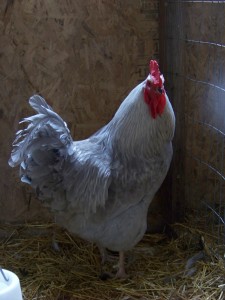 When snapping images for documentation purposes a flash can be a great tool to get fast, clear images in low light. It can stop wings mid flap, or catch a chicken running quickly. But the use of a flash can have drawbacks artistically. A flash photo will often be washed out of color. It will have very strong highlights, less detail, heavy back shadows and many times a chicken’s eyes will be reflected back and haunting looking. You also loose the actually lighting of the setting. Maybe it’s a beautiful dusky evening and the chickens are silhouetted in a crack of orange light from the sunset. If you use the flash, you will loose this subtlety of atmosphere.
When snapping images for documentation purposes a flash can be a great tool to get fast, clear images in low light. It can stop wings mid flap, or catch a chicken running quickly. But the use of a flash can have drawbacks artistically. A flash photo will often be washed out of color. It will have very strong highlights, less detail, heavy back shadows and many times a chicken’s eyes will be reflected back and haunting looking. You also loose the actually lighting of the setting. Maybe it’s a beautiful dusky evening and the chickens are silhouetted in a crack of orange light from the sunset. If you use the flash, you will loose this subtlety of atmosphere.
That being said, it can be especially difficult to get a non-blurry image when photographing chickens inside a coop or barn without the use of a flash. The reason behind this is because in order for your camera to capture enough light for the image to show up, the aperture must stay open long enough to gather light. While time is passing, if you or the subject move, the camera will pick up this movement, thus creating a blurry image. To correct this, two things must happen.
Step one, steady your self. The first thing you have to control is the movement of your own body. Cameras can pick up on the slightest movement. A slight shake of the hands, the physical movement of breathing, or the movement it takes to press the photo button. In an ideal situation, this is what a tripod is used for. But many of us don’t carry a tripod around the farm. If you don’t have your tripod handy, try to steady yourself on something that’s available. Rest the camera against a pole in the barn, or on a fence.
The next factor is the chicken itself. Since it’s near impossible to get a chicken to stay still, in fact, the more you try to settle a chicken, it seems the more they flap and move around. The best advice I have is to take a lot of photos and be patient. If you have a rapid shot setting on your camera, this can be useful. You’re working with chance in this situation. Hopefully the chicken stays still just long enough for the camera to get a good solid image.
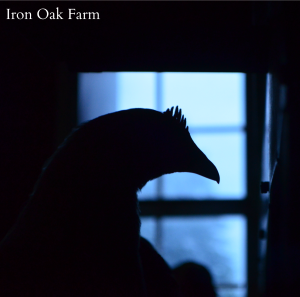 In this photo I had to take quite a few shots to get a still, silhouetted image. I used the light behind to help with the aperture and finally the chicken stayed still enough where I could catch it.
In this photo I had to take quite a few shots to get a still, silhouetted image. I used the light behind to help with the aperture and finally the chicken stayed still enough where I could catch it.
 If you simply can’t get a clear image, you have the option to add light. Open a window or door on the coop to let in more natural light. Or you can even use artificial lighting. Incandescent bulbs will give a yellow tone to your photos.
If you simply can’t get a clear image, you have the option to add light. Open a window or door on the coop to let in more natural light. Or you can even use artificial lighting. Incandescent bulbs will give a yellow tone to your photos.
Placement and Framing
 Sometimes it’s important to place the object being photographed directly in the center of the frame. If you’re photographing multiple subjects and want them similarly placed for an effect, this is a good way to show uniformity. It’s also good to highlight a breed profile, show off feathers, or a particular chicken’s body type etc. But sometimes it’s fun to move the object around.
Sometimes it’s important to place the object being photographed directly in the center of the frame. If you’re photographing multiple subjects and want them similarly placed for an effect, this is a good way to show uniformity. It’s also good to highlight a breed profile, show off feathers, or a particular chicken’s body type etc. But sometimes it’s fun to move the object around.
Try photographing the chicken off to one side of the frame. If a chicken looks as though it’s walking somewhere, give it a little distance in the photo to give it a place to “go”.
 If you’re photographing a group of chickens, rather than shooting a wide angle shot of the whole flock, try narrowing in on the closest chicken, maybe in one corner, and showing the rest of the flock behind her.
If you’re photographing a group of chickens, rather than shooting a wide angle shot of the whole flock, try narrowing in on the closest chicken, maybe in one corner, and showing the rest of the flock behind her.
Also, pay attention to what’s in your frame. Would the picture be better if the garbage can in the background was moved out of frame? Or maybe remove the bright orange bucket that you use to bring out water.
In the same light don’t manipulate the setting at the risk of looking posed or full of props.
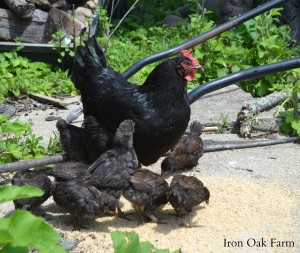 Getting chickens to cooperate
Getting chickens to cooperate
I like to stand off a bit and let chickens be chickens. Your zoom is good for capturing chickens in their most natural behavior. Many times if I get too close to our chickens they come running for treats and then they’re too close to photograph (like right under my feet).
If this happens, I sprinkle some treats where I want the chickens to be; out of the shadow of the silo for example, and then I step away to photograph them.
Don’t try to manipulate your chickens too much. The result can be awkward.
When to photograph chickens
 Sometimes it just comes down to luck so have your camera on you often.
Sometimes it just comes down to luck so have your camera on you often.
Hardly do I ever take a good photo when I’m out to get a “good photo”. Zach and I like to go for nature hikes and we have a joke between us pertaining to something like Murphy’s law. If I leave my camera at home Sasquatch will surely tap dance before us.
None the less, I carry my camera on me almost every time I leave the house. You never know when something funny is going to happen, or when the light is going to reflect just right on an iridescent feather. To capture good images you have to take a lot of bad ones and learn what you did to get that result. Be analytical.
If I had to choose my favorite time to photograph chickens, I’d have to say at sunset. I like the contrast of the long shadows as the sun lowers in the sky. The warmth of the setting sun gives everything a orange-y glow and can really highlight your chickens plumage. Red combs, wattles and chicken in the warm tone spectrum (think Rhode Island Reds) seem to glow in this type of lighting.
Use a good editing software and really learn how to use it!
I often get the impression that in the photography world there is this unspoken opinion that editing your photos after they’re been downloaded somehow cheapens your ability as a photographer.
I say that a good photographer knows how to make a good image, and is smart enough to use any tools available to create that image.
Whenever you’re photographing an animal, it’s good to have a second chance at creating the best image. Editing software gives you that opportunity. Chickens don’t always pose right where you want them to in the frame. You can use the crop tool to change that.
Maybe you forgot to move the orange bucket in the background. Crop that sucker out!
Maybe while snapping photos and tip toeing around flapping chickens you didn’t quite get the angle of the roosts level. Use the rotating tool and even things up.
A super fun and user friendly program is PicMonkey. It’s an online photo editing program that has a lot of fun filters, easy correction tools and creative frames and stickers to spruce things up. Most of it is free, or you can upgrade for a small monthly fee.
Read also: How to Photograph Chickens
—
What tricks do you use to photograph your flock. Share with a comment below, or visit the Community Chickens Facebook Page!

 Right now
Right now 











4 Comments
Very cool. I have an old anatomy book I got from an Aunt with these types of iemgas in it too. I’m a Nurse so they don’t bother me. I think the body is very cool to look at.
Great advice! Can’t wait until our little flock is past the gawky phase and a little more photogenic! =)
Thanks for all the pointers. I’m a new chicken mom, and of course I think my girls are the most beautiful ever, and as such I walk around with my camera attached to me ready to take a thousand photos. I think I’ll go check out the contest rules. Thanks for sharing.
Getting my first batch of chicks in a few weeks and I plan to take lots of pictures to document our adventures (and to post to Facebook of course!) Your tips will really come in handy! Thanks again!